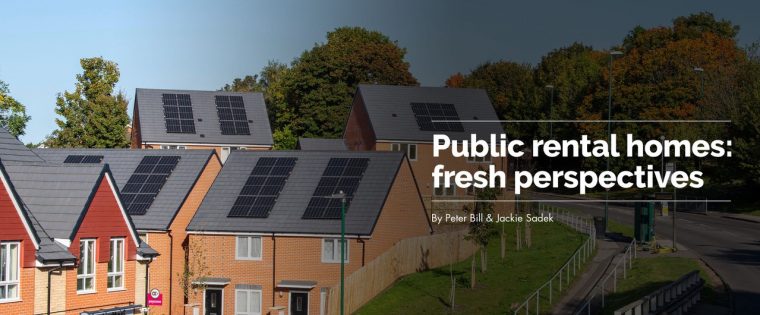Public Rental Homes
Fresh Perspectives
Author: Peter Bill and Jackie Sadek |

Just short of 250,000 new council homes were built in 1953. Housing minister Harold MacMillan permitted local authorities to build as many homes as there were applicants on the waiting list. The last year in which the current target of 300,000 homes was exceeded was in 1969, when 307,000 homes were completed: with the help of 136,000 council houses. In the 12 months to March 2021, 194,000 homes were completed, with the private sector contributing 151,000, registered providers accounting for 39,000 and councils completing just 4,000. What’s more, few of the ‘affordable’ homes being created today from new build and refurbishment projects can be afforded by those on the 1.2 million-long council waiting lists.
Well-rehearsed financial constrains make it hard for registered providers or councils to increase ‘social rent’ supply. Yet, given the government’s 300,000 target and a recognition that local authorities should have a stronger voice, the situation presents an opportunity for bottom-up initiatives, stimulated by local authorities but executed by the private sector. Public Rental Homes represents a fresh approach which flips the present private sector appraisal methodology. Instead of asking “what percentage of affordable homes can we afford to provide?”, the PRH model asks, “what percentage of private homes must be provided in order to produce the size and type of public rental homes those on our waiting lists can afford?”.
Key points
The PRH appraisal model flips the current approach, where housebuilders work out how many affordable homes of various grades they must concede to arrive at an acceptable value for the land on which they wish to build private homes, to a more bottom-up methodology. Under a PRH model, councils, in cooperation with a developer, work out how many private homes are needed to viably build homes that can be rented at rates those on the waiting list can afford.
Top-down targets are flipped as well, into bottom-up plans. The PRH model employs site-by-site appraisals to determine viability. The local authority would typically identify multiple sites as part of a strategy to reduce waiting lists, with the size and mix of the PRH homes reflecting the needs and financial situation of those on the waiting list. The percentage of PRH homes on each site is up to the council. Site by site deals are struck with the private sector. The developer takes 100 percent of the risk and reward for delivering the PRH homes. The council receives the freehold of the PRH units with rented in perpetuity covenants. The council decides how the PRH homes are managed.
The approach is deliberately loose fit – the only prerequisite for the model to work is that the homes sold privately allow the development to reach the viability threshold for the PRH. The viability of the scheme from council to council depends on residual land values. What makes a scheme ‘viable’ is the residual land value working out at zero or positive in the appraisal. If the land value is negative, then the cash would need to be found through public loans, grants, or – where appropriate – through leveraging the value of council-owned land. In a situation where the finances are in place and permission has been obtained but money is still needed to ensure the scheme is profitable – in discounted cash flow terms to the council and in rate of return terms to the developer – the gap would be filled in the same manner as for private-led sites in the current system: by the taxpayer, via Homes England. Homes England has both the money and expertise to provide aid in cash and kind on these sites.
This idea is not brand new, but rather a variant of many other ideas. Hundreds of councils are working with the private sector or housing associations to build affordable homes of all types, using all sorts of models to apportion profit and risk. The PRH model is designed simply as an additional option for consideration.
ACES recommendations
There is a cohort of (mainly, although not exclusively) RICS-accredited surveyors, professionally trained in property skills, serving as senior local government officers responsible for managing council assets. They have a membership body known as ACES – the Association of Chief Estates Surveyors in the public sector. The following proposals have been developed in consultation with the ACES leadership team.
- Local government recommendations
- Councils should set minimum levels for PRH units.
- Right to Buy rules should be altered to allow receipts to be used for PRH units.
- PRH rents should be set over ten years to create stable private investment platforms.
- For PRH units, councils should make mandatory current advisory space standards.
- Central government recommendations
- English local authorities should be mandated to have a five-year programme of house building, in line with extant policy in Wales and Scotland.
- Councils should be encouraged to build PRH, as a matter of policy.
- Councils should be incentivised by a new iteration of the New Homes Bonus for each PRH home delivered.
- A Client Relationship Manager from Homes England should be appointed to assist councils, making sure the right connections are established.
- Government should establish a PRH support team, sitting between DLUHC and Homes England but with reach across Whitehall, to support councils in acquiring land and delivering schemes. This team would be available to advise and support on the ground if requested by local authorities.
In partnership with:

